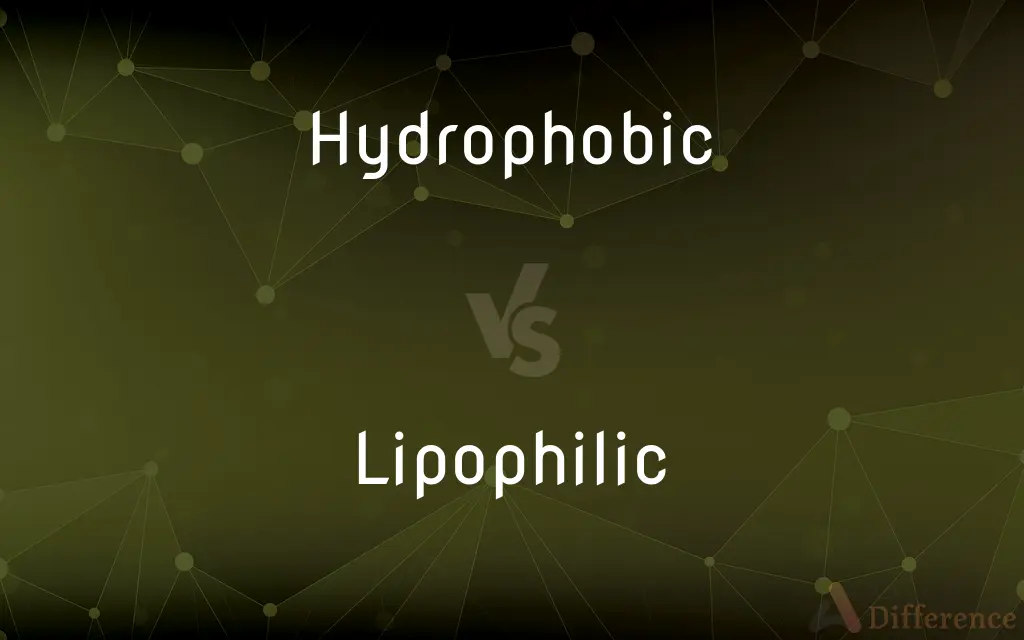Hydrophobic vs. Lipophilic — What's the Difference?
Edited by Tayyaba Rehman — By Urooj Arif — Updated on April 1, 2024
Hydrophobic substances repel water, avoiding interaction or mixing with it, while lipophilic substances attract and bond with fats and oils, integrating smoothly into lipid environments.

Difference Between Hydrophobic and Lipophilic
Table of Contents
ADVERTISEMENT
Key Differences
Hydrophobic substances are characterized by their tendency to repel water, due to their non-polar nature which makes them insoluble in water. This property is crucial in various biological and chemical processes, such as the formation of cell membranes. On the other hand, lipophilic substances have an affinity for lipids and fats, often being soluble in non-polar solvents but not in water. This characteristic makes them integral in the absorption and transportation of fat-soluble vitamins and drugs within the body.
The hydrophobic effect plays a significant role in the folding of proteins, as amino acids with hydrophobic side chains tend to cluster away from water, thereby influencing the protein's three-dimensional structure. Conversely, lipophilic compounds can easily penetrate cell membranes, which are composed of lipid bilayers, thus affecting the bioavailability and distribution of pharmaceutical compounds within living organisms.
Hydrophobic interactions are primarily driven by the tendency of water molecules to maintain hydrogen bonds with each other, leading to the exclusion of non-polar molecules. This phenomenon underlies the formation of micelles and vesicles in aqueous solutions. Whereas lipophilic substances, through their affinity for fats, can dissolve in the inner core of these micelles, facilitating their transport in biological systems.
In the industrial context, hydrophobic materials are utilized to create water-repellent surfaces and coatings, which find applications in outdoor clothing, anti-corrosion treatments, and waterproof electronics. Lipophilic substances, however, are used in the formulation of detergents, emulsifiers, and various types of ointments and creams, where their ability to interact with oils and fats is advantageous.
Hydrophobic substances often require special emulsifiers or surfactants to be mixed with water, which can alter their properties and applications. Lipophilic substances, in contrast, are more easily combined with oils and organic solvents, making them more versatile in pharmaceutical formulations and cosmetic products, where they enhance the solubility of active ingredients.
ADVERTISEMENT
Comparison Chart
Affinity
Water-repelling
Fat-attracting
Solubility
Insoluble in water
Soluble in fats and non-polar solvents
Applications
Water-repellent coatings, protein folding
Detergents, drug delivery systems
Interactions
Avoids water molecules
Integrates with lipids
Industrial Use
Outdoor clothing, waterproofing
Emulsifiers, cosmetic products
Compare with Definitions
Hydrophobic
Tending to repel or fail to mix with water.
The hydrophobic coating on the jacket repels rain effortlessly.
Lipophilic
Soluble in nonpolar solvents but not in water.
Lipophilic substances are key in making water-resistant cosmetics.
Hydrophobic
Used to describe materials that do not absorb water.
Hydrophobic materials are often used in outdoor gear to prevent waterlogging.
Lipophilic
Crucial for the absorption of certain nutrients and drugs.
Lipophilic compounds can cross cell membranes more easily than hydrophilic ones.
Hydrophobic
Characterized by a lack of affinity for water.
Hydrophobic sand placed under water forms distinct beads.
Lipophilic
Used to enhance the effectiveness of topical medications.
The lipophilic nature of the cream ensures its thorough absorption.
Hydrophobic
Relevant in technologies for separating oil from water.
Hydrophobic filters are crucial in cleaning oil spills.
Lipophilic
Important in the formulation of detergents and emulsifiers.
Lipophilic tails of detergent molecules help remove grease.
Hydrophobic
Essential for the structure and function of cell membranes.
Hydrophobic amino acids are found in the interior of proteins, away from water.
Lipophilic
Having an affinity for lipids or fats.
Lipophilic vitamins are stored in the body's fatty tissues.
Hydrophobic
Repelling, tending not to combine with, or incapable of dissolving in water.
Lipophilic
Having an affinity for, tending to combine with, or capable of dissolving in lipids.
Hydrophobic
Of or exhibiting hydrophobia.
Lipophilic
Having the quality of dissolving in lipids
Hydrophobic
Of, or having, hydrophobia (rabies).
Lipophilic
Typically have the quality of being composed of mostly nonpolar bonds
Hydrophobic
Lacking an affinity for water; unable to absorb or to be wetted by water.
Lipophilic
Having an affinity for lipids; - of chemical substances or parts of molecules. Contrasted to lipophobic or polar.
Hydrophobic
Of or pertaining to hydrophobia; producing or caused by rabies; as, hydrophobic symptoms; the hydrophobic poison.
Lipophilic
Having an affinity for lipids
Hydrophobic
Lacking affinity for water; tending to repel and not absorb water; tending not to dissolve in or mix with or be wetted by water
Hydrophobic
Abnormally afraid of water
Common Curiosities
Why are lipophilic substances important in pharmaceuticals?
They are crucial for the solubility and bioavailability of drugs, allowing them to be effectively absorbed by the body.
What is the role of hydrophobic substances in protein folding?
Hydrophobic interactions among amino acids drive the folding process, affecting the protein's structure and function.
Can hydrophobic materials absorb water?
No, hydrophobic materials do not absorb water and instead repel it.
How do detergents use lipophilic properties?
Detergents have lipophilic tails that attach to oils and fats, allowing water to wash them away.
Are all lipids lipophilic?
Yes, by definition, lipids have lipophilic properties, making them soluble in non-polar solvents.
What industries benefit from hydrophobic technology?
The outdoor clothing, automotive, and electronics industries benefit significantly from hydrophobic technologies.
What makes a substance hydrophobic?
A substance is hydrophobic if it repels water, often due to its non-polar molecular structure.
Can a substance be both hydrophobic and lipophilic?
Yes, many molecules have parts that are hydrophobic and parts that are lipophilic, affecting how they interact with different substances.
How do lipophilic substances affect nutrient absorption?
They facilitate the absorption of fat-soluble vitamins and essential nutrients into the body.
What is the significance of hydrophobic interactions in water treatment?
Hydrophobic interactions are used in separating oils and other non-polar contaminants from water.
How do lipophilic substances interact with cell membranes?
Lipophilic substances can easily penetrate cell membranes, which are made of lipid bilayers, due to their fat-attracting properties.
Why are lipophilic compounds used in creams and ointments?
Their ability to dissolve in oils and fats helps in delivering active ingredients through the skin.
What is a common application of hydrophobic coatings?
They are used in waterproof clothing and electronics to prevent water damage.
How does the lipophilic nature of a substance influence its environmental impact?
Lipophilic substances can accumulate in biological tissues, potentially leading to bioaccumulation and environmental toxicity.
What challenges arise with the use of hydrophobic substances in product formulation?
Mixing them with water-based substances often requires special emulsifiers or techniques to achieve desired properties.
Share Your Discovery

Previous Comparison
Mustard vs. Ochre
Next Comparison
Prewarn vs. ForewarnAuthor Spotlight
Written by
Urooj ArifUrooj is a skilled content writer at Ask Difference, known for her exceptional ability to simplify complex topics into engaging and informative content. With a passion for research and a flair for clear, concise writing, she consistently delivers articles that resonate with our diverse audience.
Edited by
Tayyaba RehmanTayyaba Rehman is a distinguished writer, currently serving as a primary contributor to askdifference.com. As a researcher in semantics and etymology, Tayyaba's passion for the complexity of languages and their distinctions has found a perfect home on the platform. Tayyaba delves into the intricacies of language, distinguishing between commonly confused words and phrases, thereby providing clarity for readers worldwide.














































